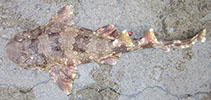| Family: |
Orectolobidae (Carpet or nurse sharks) |
| Max. size: |
112 cm TL (male/unsexed); 120 cm TL (female) |
| Environment: |
benthopelagic; marine; depth range 20 - 110 m |
| Distribution: |
Western Pacific: Indonesia (Ref. 84278); also from off Sarawak Malaysian (Borneo), and with unconfirmed records from Taiwan (Penghu Islands), and the Philippines (Visayas and Cebu City), Ryukyu Islands (Ref. 90102). |
| Diagnosis: |
This medium-sized (to at least 120 cm TL) Orectolobus species is distinguished by the following set of characters: coloration complex and variable, strongly vermiculate over dorsal and lateral surfaces with alternating dark brownish bars and saddles; dorsal and upper surface of paired fins with prominent vermicular patterns; ventral surface of trunk mainly uniformly pale; nasal barbel with a branch; preorbital dermal lobes complex, with 2-3 simple lobes in PO1 group and 3-4 simple to terminally branched lobes in PO2; simple postspiracular dermal lobes, well- developed, thallate, distance across preorbital group 1.3-1.6 times interspace between preorbital group and postspiracular lobe (PO/PO-PS1), 6.5-8.0 times base length of anterior postspiracular lobe (PO/PS1); base of anterior postspiracular lobe 4.3-5.3 in its distance from postorbital group (PO-PS1/PS1), 2.5-2.9 in its distance from posterior postspiracular lobe (PS1-PS2/PS1); enlarged supraocular knob or warty tubercles on back absent; dorsal fins tall, upright; first dorsal-fin origin near insertion of pelvic fin; tip of pelvic fin below insertion of first dorsal fin; interdorsal space 0.5-0.8 times anal-fin base length; anal-fin inner margin 0.7-0.8 of anal-fin posterior margin; 23 tooth rows in upper jaw, rudimentary row of teeth at symphysis of upper jaw usually present; monospondylous centra 44-51; total vertebral centra about 148-163 (Ref. 84278). |
| Biology: |
The depth range of this species is not well defined; specimens observed at fish markets
were presumably caught by longline fishers operating in deeper parts of the continental shelf. It probably prefers deeper colder water with a single shallow water observation from the east
coast of Bali where cold-water upwelling is common. All males (n = 43) mature by ca 90 cm TL; smallest mature female recorded at 94 cm TL, two pregnant females recorded at 104 and 108 cm TL, smaller of the two pregnant females contained 4 mid-term embryos between 13 and 14 cm TL (Ref. 84278). |
| IUCN Red List Status: |
Near Threatened (NT); Date assessed: 19 May 2020 (A2d) Ref. (130435)
|
| Threat to humans: |
harmless |
Source and more info: www.fishbase.org. For personal, classroom, and other internal use only. Not for publication.
